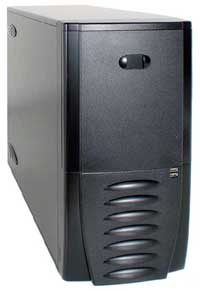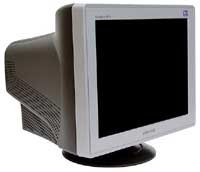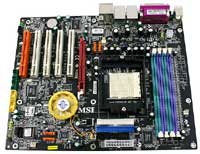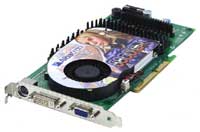AMD Mid-Range Gaming System
If you want some more
oomph in your system - say you like higher resolutions and antialiasing, or maybe you're a competitive online gamer - you could upgrade a few parts in the Budget System and end up with acceptable performance. We're going to kick it up another notch for the Mid-Range segment by improving nearly every component.
| Mid-Range AMD Athlon 64 System |
| Hardware |
Recommended Component |
Price |
| Processor |
AMD Athlon 64 3500+ 512K 2.2 GHz (939) 90nm |
285 |
| Motherboard |
MSI K8N Neo2 Platinum |
131 |
| Memory |
Mushkin Dual Pack 2x512 PC3200 2.5-3-3 |
159 |
| Video Card |
Albatron GeFORCE 6800 GT 256MB GDDR3 |
374 |
| Hard Drive |
Seagate 160GB SATA 7200RPM 8MB Model ST3160023AS |
93 |
| Optical Drive |
NEC DVD+/-RW Drive Model 3500A |
72 |
| Case and Power Supply |
Antec SLK3700-BQE with 350W |
91 |
| Display |
Samsung SyncMaster 997DF 19 CRT |
234 |
| Speakers |
Logitech Z-640 5.1 |
52 |
| Keyboard |
Logitech Internet Keyboard |
17 |
| Mouse |
Microsoft IntelliMouse Optical |
24 |
| Bottom Line |
|
1532 |

Click to enlarge. |
We return to several components that we have recommended in the past for the Mid-Range system. We've doubled the amount of RAM, and we've upgraded the case and PSU to the Antec SLK3700-BQE. It's not a flashy case, so if you're interested in that, you might look elsewhere. Nevertheless, it is a well thought out design, and the use of dual 120mm fans provides ample cooling when you add in the front fan. For the monitor, we have upgraded to a 19" CRT, which has the ability to run at 1600x1200 with a 75 Hz refresh rate. The NEC FE991SB is also an option, although it costs $40 more. We have upgraded to a Serial ATA hard drive with 160GB storage capacity, again staying with Seagate and their five-year warranty. Most of the other base components remain the same, although we opted for the five-button Microsoft IntelliMouse Optical this time.

Click to enlarge. |
The major changes come in the selection of motherboard, CPU, and graphics card. This should come as no surprise, as we have already mentioned several times that these are the most important aspects of a gaming system. For the processor, we have upgraded to an Athlon 64 3500+. The raw clockspeed advantage is not that great, but our
initial tests of the 90nm parts show a slight performance increase relative to the older 130nm 3500+, particularly in games, and it also has better overclocking capabilities if you're interested in that. The power use of the 90 nm parts is also substantially lower than the 130 nm design. The total price increase is $20 relative to the 130nm part, so either one is fine. The motherboard that we have selected uses the NForce3 250 Ultra chipset, and it was also our Gold Editor's Choice in our
Socket 939 Motherboard Roundup. There are several socket 939 motherboards with similar features that use the VIA K8T800 Pro chipset, but we have stuck with the NVIDIA chipset as tests have shown that it has a slight performance advantage when used with an NVIDIA graphics card compared to boards using the VIA chipset. ATI boards do not incur any penalties either, should you choose to go that route. If you prefer the VIA based boards, the Abit AV8 and Asus A8V both received our Silver Editor's Choice.

Click to enlarge. |
Speaking of graphics, our recommendation goes to a GeForce 6800GT AGP model. With 16 pixel pipelines, a 350 MHz GPU core and 1 GHz GDDR3 RAM, it provides nearly twice the performance of the 9800 Pro and significantly more than the 6600GT as well. Performance doesn't vary much if at all between the various manufacturers, so we have selected the card that we could find for the lowest price. You could also look into spending a bit more for a BFG 6800GT OC model that comes factory overclocked or the Leadtek model with it's larger two-slot HSF, but otherwise there is not a whole lot to differentiate among the designs. For ATI lovers, the X800 Pro actually offers very similar performance to the 6800GT. It only has 12 pixel pipelines, but since they're clocked at 475 MHz instead of 350 MHz, it ends up as almost a tie. The 6800GT has faster RAM - 1 GHz compared to 900 MHz - and it also includes Shader Model 3.0 support, not to mention a lower price. If you can find the X800 Pro for less than the 6800GT, though, it's definitely worth considering.

Click to enlarge. |
Then again, the AGP socket could become something of a limitation for upgrades by that time. We have recently previewed the
NForce 4 chipset as well as
ATI's RX480. Both should be available for purchase before the end of the year, and the NVIDIA boards will likely start showing up by the end of this month. If you're considering a socket 939 platform, and assuming you're willing to pay the price premium, it could be worth waiting for the PCI Express motherboards to ship. We'll take a look at PCI Express costs with our Intel Mid-Range alternative. SLI is also a very attractive feature for those looking to buy one card now and upgrade later. All told, an SLI-capable system will probably cost about $100 more than an equivalent AGP setup, but with AGP you're stuck with one graphics card.














70 Comments
View All Comments
Arkali - Tuesday, November 23, 2004 - link
For Intel gaming you should have picked the new AOPEN socket 479 855GME motherboard and a Dothan processor.Glassmaster - Monday, November 22, 2004 - link
#30 Doesn't look like they are going to defend their PSU recommendations. I just want to know if they actually build and stress test these systems with the Generic PSUs to make sure their recommended systems really are reliable.Glassmaster.
Live - Monday, November 22, 2004 - link
I like the format of this guide. I think the guides in general has been a great addition to Anandtech.To bad PCI-e motherboards is not out yet. Since the sli previews are not out in force yet I'm still not 100% sure if its something you want on your motherboard for more upgradability but it sure looks like it is not. Too expensive both in terms of motherboard and the 2 cards. But for a gamer, investing in anything else then PCI-e seems like a bad move. Unless you like to buy second-hand. I bet a lot of AGP cards will soon be available on the market as the high end crowd switches to the latest.
mldeveloper - Monday, November 22, 2004 - link
i like the format of this guide, since i always jumped to the end to see the final price breakdown anyway.nurazlanshah - Monday, November 22, 2004 - link
is the a big difference in fps between 128mb and 256mb for a same graphic card?deathwalker - Monday, November 22, 2004 - link
Jarod...great writeup. Ignore all the sniping. It's a tough job doing a article like this and sometimes there just aren't any absolute rights and wrongs. Somepeople just like to pipe-off and be heard.AaronAxvig - Monday, November 22, 2004 - link
#15 I think if you really wanted maximum performance for a LOT of money, you would go with RAIDed SCSI. Very fast, no?Momental - Monday, November 22, 2004 - link
Fantastic article, Trog......I mean Jarrod. ;)I was considering going the SLI route with (2) two 6600GT's, but then realized that the performance is identical to that of one 6800GT. And who wants to take the chance of one of the GPU's defecating the bed? Additionally, the cost of the SLI-capable board ain't gonna be cheap. I will, however, wait for the VIA and nVidia PCI-e boards to become available before finally building a new system.
The only thing I might change from the mid-range system is to put in the lower latency RAM, such as the OCZ Plat Rev. 2 or the Ballistix. Pop on a good aftermarket HSF on the CPU and we're good to go!!
gilkman - Monday, November 22, 2004 - link
Very nice article. It's been a few years since my last homebuilt but with the new games it's def time to upgrade. I like the format of this article. It gives me a few more options and insight compared to the similar guides they have over at sharkeyextreme.comI am def looking at high end parts to put together and I was very interested in the Dell 20 inch widescreen LCD - Does anyone have any comments on using a widescreen LCD for games? The Dell widescreen has 16MS refresh and high resolutions, and I know that HL2 will support widescreen play, but what about other modern games like RTS's and RPG's? Is it safer to stick with a 4:3 screen?
SDA - Monday, November 22, 2004 - link
Looks good, but I object to using a cheap PSU for a lot of the systems. It's worth the small amount of extra money you pay to get a better PSU... a TON of the problems I've seen in DIY systems resulted from cheapo PSUs that couldn't deliver enough power or simply couldn't deliver clean enough power. Cheap PSU = false savings, IMHO. There are plenty of good PSUs out there for cheap (TTGI, CWT aka Antec).And yeah, sure, the budget rigs don't stress the PSU much. I still hold that you shouldn't go generic. Having looked inside a lot of generic PSUs, I can safely say that I wouldn't ever want to see one in ANY system I build.